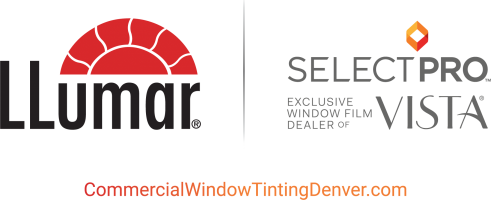Commercial Technical Definitions
Commercial Window Tinting Denver Technical Definitions
[/fusion_text][separator style_type="single" top_margin="0" bottom_margin="35" sep_color="#e2e3e8" border_size="3px" icon="" icon_circle="" icon_circle_color="" width="170px" alignment="left" class="" id=""][/one_full][accordian divider_line="" class="" id=""][toggle title="Total Solar Transmittance:" open="yes"]
The ratio of the amount of total solar energy in the full solar wavelength range (300-2500 nm) that is allowed to pass through a commercial glazing system. The value is expressed as a percent.
[/toggle][toggle title="Total Solar Reflectance:" open="no"]The ratio of total solar energy which is reflected outwardly by a glazing system to the amount of total solar energy falling on the glazing system. On commercial filmed windows, this reflectance is a function of the side of the film facing the exterior of the building. The value is expressed as a percent.
[/toggle][toggle title="Total Solar Absorption:" open="no"]The ratio of the amount of total solar energy absorbed by a commercial glazing system. Solar absorption is that portion of total solar energy neither transmitted nor reflected. Total solar absorption is nothing more than center of glass temperature. This function however is what causes glass breakage in Colorado. We don’t recommend installing solar films in Colorado on double pane glass if the film has a solar abortion of more than .45%. We have been installing film for 33 years in Denver and vast commercial window tinting experience.
[/toggle][toggle title="Visible Light Transmittance:" open="no"]The ratio of the amount of total solar visible solar energy (380-780 nm) that is allowed to pass through a commercial glazing system. The value is express as a percentage and is photopically weighted to account for the greater sensitivity to the human eye to the center region of the visible spectrum.
[/toggle][toggle title="Visible Light Reflectance:" open="no"]The ratio of the amount of total visible light (380-780) reflected by a commercial glazing system to the amount of visible light falling on that system. This value is expressed as a percent. The higher the visible reflectance of a glazing system, the more mirror-like its appearance. Visible reflectance values may be given for the interior or exterior side of the glazing system.
[/toggle][toggle title="Winter U-Value:" open="no"]The overall heat transfer coefficient of the glazing system, U-value is a measure of the heat transfer that occurs through the glazing system and its outer and inner surfaces. This value is a function of temperature, and it is expressed in BTU per square foot per hour per degree-Fahrenheit (BTU/sq./hr./°F). The lower the U-value the better the insulation qualities of the glazing system. This value is measured at 0° F outdoors, 70° F indoors with a 12-mph wind.
[/toggle][toggle title="Shading Coefficient:" open="no"]Shading Coefficient (SC) is the ratio of the total amount of solar energy that passes through a glazing system relative to 1/8-inch (3.0mm) clear glass under the same design conditions. It includes both solar energy transmitted directly plus any absorbed solar energy re-radiated and convected. Lower shading coefficient values indicate better performance in reducing solar heat gain in a commercial office building.
[/toggle][toggle title="Ultraviolet (UV) Protection:" open="no"]Commercial office buildings in Denver, Colorado experience damage from the intense Colorado sun. This is one of the most important reasons to install commercial window film. Damage to your building and your skin increases by 5% for every 1,000 feet in elevation of where your office building is located.
The ratio of the amount of total UV solar energy (280-380 nanometers) that is not allowed to pass directly through a glazing system to the amount of total UV solar energy falling on the glazing system. Ultraviolet radiation is one portion of the total solar energy spectrum which greatly contributes to fading and deterioration of fabrics, flooring and furnishings.
[/toggle][toggle title="Emissivity:" open="no"]This is what sets us apart from the competition. Our commercial films are made for Colorado by reducing winter heat loss. Our competitor’s films are made for sunbelt type climates like Arizona. Colorado is a heating state, not a cooling state.
The measure of a surfaces ability to emit long-wave infrared radiation or room temperature radiant heat energy. The lower the emissivity the better the windows insulating performance. Low emissivity films reflect radiant heat back into the room, helping to lower heating costs.
[/toggle][toggle title="Solar Heat Gain Coefficient:" open="no"]Measures how well a window system blocks heat caused by sunlight. SHGC is the total fraction of incident solar energy that passes through a glazing system, directly and indirectly, via direct transmission or indirectly via conduction, convection, and re-radiation of absorbed solar energy. The lower a windows solar heat coefficient, the less solar heat is transmitted.
[/toggle][toggle title="Total Solar Energy Rejected (TSER):" open="no"]The total percentage of incident solar energy that is prevented from passing directly or indirectly through a commercial glazing system. The higher the number the more heat rejection achieved. This is very important on hot afternoons with southern and western facing glazing.
[/toggle][toggle title="Light-To-Solar Heat Gain Ration:" open="no"]The ratio of visible light transmittance (in decimal form) to the solar heat gain coefficient. Commercial films with values approaching or exceeding 1.0 reject a larger percentage of solar heat from the infrared portion of the solar spectrum rather than from the visible light portion.
[/toggle][toggle title="Summer Solar Heat Gain Reduction:" open="no"]The percentage by which incoming solar heat energy is reduced by the addition of a filtering material. The higher this number, the greater heat gain is reduced.
[/toggle][toggle title="Winter Heat Loss Reduction: **(Our Eastman LLumar/Vista films are superior to all other films in this category)**" open="no"]The percentage by which heat energy loss through a given glazing system is reduced by the addition of an insulating material. The greater this number, the better.
[/toggle][toggle title="Glare Reduction" open="no"]The percentage by which visible light is reduced by the addition of a light filtering material.
[/toggle][/accordian][/fullwidth]]]>